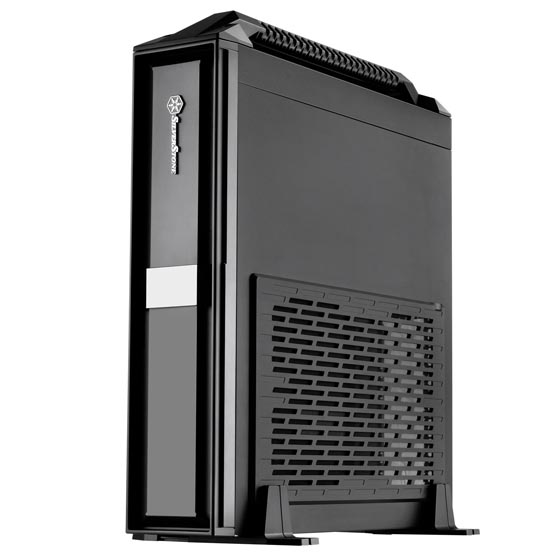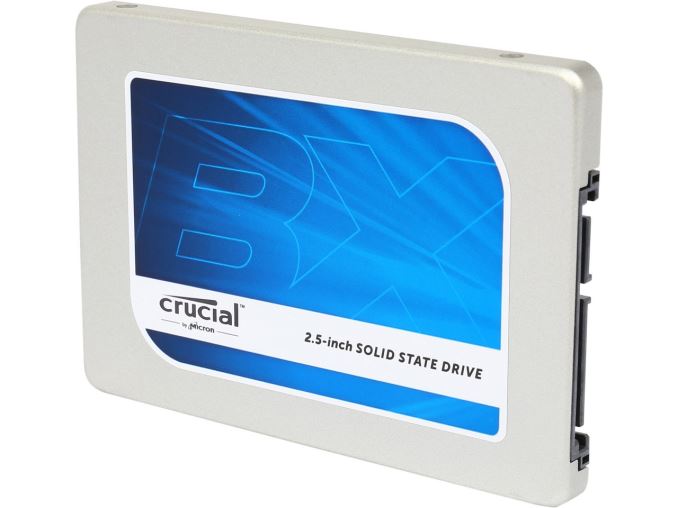Build-A-Rig Round 2: SilverStone and Crucial Interviews and $800 Back-To-School PCs
by Ian Cutress on October 13, 2015 8:00 AM EST- Posted in
- Build-A-Rig
- Crucial
- SilverStone
- Interview

Last quarter we introduced our new Build-A-Rig project. At a high level, we ask two or three companies in the PC industry each round to configure a system to a budget. Then, with our partners Newegg, we build and test each system in glorious battle, along with interviewing the participants about how they approach the industry. Regardless of the winner, all the systems built are given away to our lucky readers. Imagine Top Gear UK’s ‘Star In A Reasonably Priced Car’, but instead of celebrities racing around a track, we let the configured PCs do the racing where both style and performance count. In this round, given the timing as school is starting, we chose SilverStone and Crucial with a budget of $800 for a back-to-school system.
The Rules
When we approach the companies to configure within a budget, there are certain rules they have to follow in order to be fair:
- All components must be available at Newegg.com at the time of selection (so no pre-choosing unreleased parts)
- No combo deals will be considered
- No mail-in-rebates will be considered
- Components must be compatible
- There will be sometimes be a price difference between configuration and giveaway, so a 3% leeway is given on the overall build budget if prices change
- There is no compulsion to use the hardware of who you’re up against
- Each round, we will let the companies competing know who they’re up against, but not the build until it is published on AnandTech
- Each company must agree to an interview on their build
This means that whatever the budget, each participant might end up deciding a different sized build, or a different concept (Steam box or hardcore gaming). As we have found out, it also means that each participant has a stringent choice – either select their best components and perhaps have to reduce the rest of the build to fit the budget, or choose the best performance and only their own mid-or-low range hardware.
Of course, for each build by the companies that actually make the hardware, we also want our readers to chime in with their own thoughts. What would you do differently?
It should be noted that for Round 2, companies were asked to supply builds before September 25th. This makes sourcing Skylake parts somewhat troublesome.
Previous Build-A-Rig Rounds
Here are links to our Build-A-Rig Introduction and previous challengers:
Round 1: $1500 Single Monitor Gaming PC
Corsair's 'The Accelerator', as chosen by Dustin Sklavos (Interview, Breakdown, Build Log, Results)
Zotac's 'Hey Good Lookin', as chosen by Chinny Chuang (Interview, Breakdown, Build Log, Results)
The Contest
This is Round 2 of our glorious project, and given the September-October timeframe, we asked our contestants to produce a specification list for a system that costs $800, with a focus on back-to-school operation. For the parts list, this means the following:
- Processor (CPU)
- Motherboard
- Graphics Card(s) (GPU)
- Memory (DRAM)
- Storage (SSD or HDD, or both)
- Power Supply (PSU)
- Chassis (Case)
- CPU Cooling
- Operating System
- Extras
Obviously there are more elements to a full system than this, particularly when discussing the monitor, keyboard, mouse, mouse mat and other utilities, although we will reserve that choice of rounds with a bigger budget to play with. Something like a monitor is arguably a 10-year lifecycle purchase, whereas keyboards and/or mice are either upgrades from something very simple or replacements when breaks occur.
Because we only specified $800, this opens up how both SilverStone and Crucial have interpreted what this means and we get very different builds focusing on performance and style.
The Participants – Tony Ou from SilverStone Technology
Despite the look of youth, Tony is an industry veteran. We first crossed paths back at Computex 2011, my first major industry event, and I was instantly struck by Tony’s own knowledge about his own product lines and how they fit into the industry as a whole. Every case has a story to tell, and I remember the discussions we had around the push for a Thunderbolt-based graphics dock, as well as some words about the difficulties of producing such a device. Tony is very much into his gaming PC cases as well as the small form factor builds, echoing the sentiment of his employer.
The Participants – Jeremy Mortenson from Crucial (Micron)
The best way to think of Crucial is a brand of Micron, whereby Crucial sells more to end-users and Micron focuses on DRAM IC production, NAND, and business customers. Jeremy covers both, and like Tony he has been in this industry a good number of years and flexes that knowledge to the fullest. This leads to some interesting conversations around the $800 build here, as Jeremy has approached the build somewhat differently for the cooling and OS choice than I suspect 95% of our potential participants would have done. He's also an avid gamer, with a collection stretching back over 20 years of important industry titles.
Up Next: Interview with Tony Ou (SilverStone Technology)













93 Comments
View All Comments
coconutboy - Thursday, October 15, 2015 - link
Awesome to see Tony Ou up at bat. Dude has been great in his community/forum interaction and Silverstone has produced some awesome and compelling rethinks of pc case design these past few years. Little doubt Tony's had something to do with that.Too bad then Tony, that you've lost this round. I'm not talking about the build-a-rig battle, I'm talking the pictures on page 1. Jeremy Mortenson's game face is AWESOME, and sets a new standard for all future competitors in build-a-rig duels. He even has nunchucks and appears to be ready to enter a no-holds-barred cage fight!
As far as the systems, man... very tough call. Tony and Silverstone have the better case and vid card, while Jermey and Crucial have the better ssd and cpu. It's close, but I think I'll give my vote to Mighty Milo. I love that case with it's small footprint and brilliant design, and it'll be the better gaming machine with that gtx 960oc. Then again, that rig is more likely to eat up a students time and have them flunking out of classes because they're hooked on DotA!. Maybe Jeremy's better cpu will help students finish school tasks quicker while not tempting them to spend so much time gaming. ;-)
coconutboy - Friday, October 16, 2015 - link
Noticed a few prices have changed since the post date, but figured I love these build-offs so much, I'd tinker with my own while watching the MLB playoffs. I'll say up front I really wanted to use the same case as Tony's Silverstone build (including the handle, it's totally worth the $10 increase) because that thing is just badass, just look at that tiny footprint! Buuuut... since I'd rather not be a complete copycat, I tried to offer some different options with explanations after the list.coconutboy's cool white chiller:
cpu: intel core i3-4170 $125
note: no aftermarket cpu cooler, stock intel
mobo: asrock h81m-itx/wifi $63
gpu: msi gtx 960oc $180
ram: corsair vengeance 8gb cas 9 low profile ddr3 1600 $41
storage: no hdd, only crucial's bx100 500GB ssd $150
psu: corsair cx430m 80 plus bronze modular psu $50
case: xigmatek aquila white steel micro-atx cube chassis $90
os: windows 10 home oem $100
total cost: $799
Breakdown of parts:
cpu: I love that Tony gave a shout out to the overclocking crowd with the g3258, but Jeremy nailed this one. If Windows 10 microcode concerns about nerfing the oc become long-term reality, then that Pentium cpu loses most of its appeal. Meanwhile the i3-4170 can handle 4 threads, is clocked 500MHz higher out of the box. No ocing required is very welcome in a tiny itx case packing a 120w vid card.
mobo: easily the most debatable part of this build. Like Jeremy's gigabyte board, this asrock only has 2 usb3.0 ports (and 4 usb 2.0 ports). Unlike Jeremy's mobo which can add more usb3.0 via headers, this asrock only offers up more usb2.0 headers, so 2x usb3.0 is all you get, period. My chosen mobo's intel h81 chipset also limits you to pci express 2.0 instead of 3.0, and only offers wireless b/g/n wif instead of the ac seen on Tony and Jeremy's picks.
"Wow that's a lot of freakin' compromises!", you say? Aye, but the questions are, will they actually have an impact, and would you even notice? The usb 3.0, that's something each individual has to address for themselves. PCI Express 2.0 vs 3.0 with single gpus has been covered in depth most recently by guru3d, but hardocp/anand/toms/etc have also done tons of great write-ups. The difference is either nonexistent or at most 2% when using the latest high-end cards like a gtx980 or better. With a gtx 960oc it won't matter.
The wireless ac vs b/g/n could be something that might be more noticeable to the end user however, so if that or any of these issues concern you, upgrade to either of the mobos recommended by Jeremy/Tony.
gpu: the white MSI will look great through the white Xigmatek case's window, but even better is that it gets excellent reviews. A very strong alternative tho is the Powercolor PCS+ Radeon r9 380 axr9. Not as pretty in the case, but for $10 less than the msi, the powercolor card is generally going to be even faster at the expense of greater power draw. ymmv
ram: excellent reviews and the low profile make it a tad easier to fiddle about inside a tiny itx case.
storage: it's not the fastest, but very reliable with excellent reviews. I think most folks would prefer a 500gb ssd over a hybrid setup with only a 1TB hdd.
psu: a 5.9" deep modular and inexpensive corsair to clean up that tiny case. 'nuff said.
case: like the mobo, one of my toughest choices. The Corsair 250d looms large here for essentially the same price. Then there's other great options like the Fractal Node 304 for $65, Jeremy and Tony's choices, or unusual but potentially awesome stuff like the Xigmatek Nebula C for $60. Want a portable case that can take a bit of a beating? Check out the Azza csaz-105 which is basically a modern version of the mods from the late 1990s where people would stuff their computer into a portable briefcase or some such. Really, options for cases are always endless and fickle for every user.
I picked the Xigmatek because, like the Nebula, it looks fantastic, but also because it's known to be quiet and has so many other niceties like top front and bottom dust filters. The mobo being laid horizontal increases the footprint of the case to a similar size as the 250d or Jeremy's Thermaltake cube, but in exchange it shows off the vid card through the side window. The huge 200m fan up front along with 120mm out back is solid for cooling, but you can increase this further if you like by mounting up to a 240mm radiator up top (but losing the 5.25" bay in exchange. Being able to install 4 internal hdds is also great. Overall, the case has a lot of flexibility with a good reviews both on newegg and websites.
/mic drop
SUpstone - Friday, October 16, 2015 - link
Good build list - that's a sweet PCDLimmer - Friday, October 16, 2015 - link
First, I hope that both boxes are tested with GeForce GTX 960s in them, since the second build was $20 less than the first, and that's the difference between video cards.Secondly, If I were to make one, I would trim the fat in order to get a quad core CPU. Here goes:
CPU - Intel Core i5-6400 $190
Mobo - Gigabyte GA-H110M-A (rev. 1.0) LGA 1151 Intel H110 $56
(1st corner cut)
GPU - MSI Radeon R9 380 R9 380 GAMING 4GB LE 4GB $200
RAM - Crucial 8GB (2 x 4GB) DDR4 2133 $48
SSD - ADATA Premier SP600 256GB SSD $70
(2nd corner cut)
HDD - none
PSU - Antec EarthWatts Platinum Series EA-550 $80
Case - Antec ISK 600M Black Aluminum $70
CPU cooler - none/stock
OS - Windows 10 $100
Total: $814
Performance should be near unbeatable at this price. The only way to improve is to skimp on the case and power supply in order to select a better SSD.
That said, with $400 to spend next year, I would purchase a wi-fi card, HDD, a better SSD, and possibly a slim optical drive. ($50 / $150 / $150 / $50).
Weaknesses: no Wifi, single/slower SSD, small storage (removed in 1 year)
Strengths: Quad core Skylake, R9 380, efficient/ample power supply
coconutboy - Friday, October 16, 2015 - link
Nice build. For people that stick to just one game or maybe carry the bulk of their data on portable hdd/usb, the 256 should be fine. Meanwhile the beefy cpu and gpu's 4gb vram give a lot of oomph that don't need upgrading so quickly.Even better, as http://techreport.com/news/28957/the-skylake-core-...">Scott Wasson astutely pointed out, your build gets even more affordable when the Skylake i3-6320 releases. That cpu would sacrifice 2MB of L3 cache, but has a base clock that's a whopping 600MHz higher than the Core i5-6400's turbo maximum.
SaintStryfe - Tuesday, October 20, 2015 - link
For a college student, no Wifi isn't a problem, most students have an Ethernet jack right in the room. That's fine by my book.Tchamber - Friday, October 16, 2015 - link
Wow, both are compelling systems. It's amazing how much performance we have available for such a reasonable price!lindda8764 - Saturday, October 17, 2015 - link
hiiiiiKokapelli - Sunday, October 18, 2015 - link
while this might not be in the spirit of picking each and every individual part, there are numerous deals to be had on newegg in terms of buying an "off the shelf" pc with an i5 for around $500. Take the remaining $300 and get the 960, or maybe even a 970 on sale. End result beats both of these. There's also several prebuilt gaming computers with various i5's + 960s as well as FX8k series + 960s for less than 800, and all of these options come with windows.DLimmer - Monday, October 19, 2015 - link
I just looked, and it's $450 for a 4GB memory option and $500 for 8GB DDR3. So, you add $200ish for the best affordable video card (R9 380 4GB is $205) and $70-95 for a SSD and you come out ahead (a 500GB-1TB hard drive)... or do you?You're missing out on Skylake and your power supply may not be able to handle the video card upgrade.
($799 for i5, 8GB, R9 380 2GB, 2TB HDD, 120GB SSD)
http://www.newegg.com/Product/Product.aspx?Item=N8...
in fact, the same maker sells the box I made (with 2GB video card, half the SSD, but adds a 2TB HDD) for $950.
Bottom line: making your own is the the fastest option.
http://www.newegg.com/Product/Product.aspx?Item=N8...